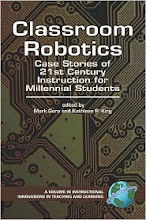Tips for using coding, robots in the classroom
However, last year I had the opportunity to use KUBO from Pitsco Education, a screen-free robot for early learners. Students use TagTiles that fit together like puzzle pieces to code and tell the robot where to move. Students were able to pull the materials straight out of the box and begin using the TagTiles to move their robot around an activity map. They were completely engrossed in the activity. This is critical when teaching kindergarten, first and second graders; they need something immediately engaging or I’m struggling to keep their attention. But for those 30 minutes with their KUBO, they actually seemed to forget they were learning math.
I have also learned alongside my students. It is hard to let go of some of the control of instruction, but nothing is better than seeing a kindergarten student’s face light up when they realize they taught their teacher something about robots or coding. I embrace those experiences that capture student interest and open their minds to think and learn in new ways.
For teachers thinking about trying a new robot or coding in their classroom or for those who, like me, haven’t even considered it, here are four positive takeaways from my experience:
- Explore first. Let students dive in with the new resource and explore its capabilities. I never give my students an assignment when we first pull out KUBO. I explain what the TagTiles are and their function, but I then give students the opportunity to make their own code. It is extremely rewarding to see their excitement when they make their robot move along their path -- successfully or with failures. They are learning through exploration.
- Students love to teach their teachers. It’s absolutely OK if you don’t know everything about the robot or how to code, let alone have used any technology in your classroom. Research shows we learn best when we teach someone else, so let your students learn how to code and then show you. This will deepen their understanding of the coding concepts, as well as create more excitement for the students since they love to teach something to their teachers.
- Encourage failure. Since I teach struggling math students, many do not want to attempt math problems because they’re embarrassed to be wrong. However, when given the chance to code and work with robots, they don’t hesitate to jump right in and fail. Students routinely fail as they work to move their robot around a path. While some get discouraged when they cannot figure out the appropriate code, this is a wonderful opportunity to encourage a growth mindset and get comfortable with the notion that failing is OK. It is part of the process where they can then build from their failure, persevere and learn from their mistakes. One of the best experiences I have had was watching an English language learner who struggles with most reading and math concepts when they are first explained to him. When he was asked to code, he was able to visualize and create the correct sequence with his first attempt. His peers were amazed at how he could manipulate his robot without fail. It was incredible to see him succeed and be able to teach his peers.
- It’s not just for STEM programs or computer science classes. Before adding coding and robotics into my math class, I thought these were tools that were only meant to be used in computer science classes, STEM programs or by education tech specialists. I didn’t realize the numerous applications that both can add to any subject. For example, I was able to use the robot with upper grades in my math classroom to code the difference between perimeter and area. It also taught them important communication skills, to think critically and to work in a team. For instance, sometimes partner and group activities can create tension with students, but I observed that my students were excited to learn from each other when coding; they worked through struggles together.
- Looking for a product that is easy and quick to implement in the classroom. No one has loads of extra time to explain and teach students to code their robot.
- Using different coding and robotics solutions that are out-of-the-box experiences for students. There is so much that students can learn through exploration, you do not have to buy solutions that require direct instruction throughout to understand.
- Following educators on Twitter or Instagram that are using coding and robotics in their classrooms; connect with them, ask questions and get a preview of how their students are using the product.
Read the full article at its source: https://www.smartbrief.com/original/2019/08/tips-using-coding-robots-classroom?utm_source=brief&utm_medium=FeaturedContent&utm_campaign=EducationOriginals



No comments:
Post a Comment